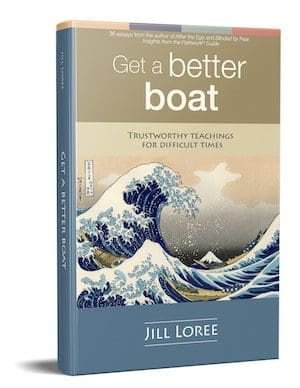There are so many things to love about the Japanese woodblock print on the cover of this book. It is by the artist Hokusai and is commonly known as The Great Wave off Kanagawa. It’s also just called The Great Wave or The Wave. Some consider it to possibly be the most reproduced image in the history of all art.
Created in roughly 1831, it depicts three boats holding 30 men—22 of whom are shown—moving through a storm-tossed sea. These boats are transporting live fish to market, and we can see Mt. Fuji in the background. The most notable feature is the giant wave, central to the image, which appears to have many claws.
Also outstanding, although not so amazing today, is the vibrant blue color in the print. This came from a dark blue pigment called Prussian blue, imported into Japan from Holland beginning in 1820. Indigo was more common at the time but faded quickly.
Although only 1000 copies were initially made, as many as 8000 prints are estimated to have been created from the woodblocks. And each print varies due to wear of the blocks. The first sign of wear can be seen in the pink and yellow of the sky, resulting in vanishing clouds. Of the 111 original prints identified by one historian, 26 show no visible clouds.
Inspiration crosses time and distance
Back in 1859, Japan opened its markets to imports from the West. In turn, Japanese art began being exported to America and Europe, and it quickly became very popular. The sudden influence of Japanese art, such as this woodblock print, brought new inspiration to American and European artists like Whistler, Van Gogh and Monet. In other words, this print became an inspiration for the Impressionist era.
In the upper left corner of the picture are two inscriptions. In the rectangular frame is the title, which reads: “冨嶽三十六景/神奈川冲/浪裏” or “Fugaku Sanjūrokkei / Kanagawa oki / nami ura,” meaning “Thirty-six views of Mount Fuji / On the high seas in Kanagawa / Under the wave.”
To the left of the title is the name of the artist, Hokusai, painted with a brush. Due to his humble origins, he did not have a last name. His first nickname, Katsushika, was the name of the region he was from. Throughout his career, he would change his last name each time he started a new cycle of work, using over 30 different names.
This series was called Thirty-six Views of Mount Fuji and was published when Hokusai was about 70. It was so popular, he later added ten more prints to the collection. Hokusai died at the age of 89, in 1849, a decade before the Japanese borders opened up. He’d had a passion for art since the age of six, and only started publishing drawings at 50. “Yet of all I drew by my seventieth year there is nothing worth taking into account.”
It’s unfortunate he would not know the magnitude of the inspiration his work would create throughout the world. Even today, The Great Wave is so popular, in 2024 it will be used on the Japanese 1000 yen banknote.
Symbolism drips from The Great Wave
Jill Loree was inspired to create this collection of essays when she wrote the last one: So, how’s your little boat doing? This essay embodies the symbolism of bookends in the way it combines boat analogies from both the first and last Pathwork lectures. And the last subhead in this essay really stands out: Get a better boat. So here we are.
The first book cover design was originally quite different from this one. But then her husband, Scott, began describing an image of a Japanese wave illustration he was seeing in his mind’s eye for the cover. (Note, he had not previously contributed ideas for book covers.) She went on to find this illustration, which matched what he was describing. (Read more about this fascinating phenomenon in The key to a happy marriage? Honesty.)
Only after some research did she learn the rich and deep history of this artist and his inspiring piece of artwork. And then she found herself feeling newly inspired. Because she got a better boat—in the form of a better book cover—when she allowed inspiration to come from somewhere she didn’t expect.
So much other symbolism can be found in this cover artwork. For example, in the background is snow-capped Mt. Fuji, where the weather is calm. This creates two dominant forces in the visual space. There is the violence of the great wave—foaming with animal claws and forming a shower of droplets—as well as the serenity of the peaceful mountain. Both are present. For some, this evokes the yin and yang symbol, which is central to Buddhism.
Many ways to get a better boat
The Japanese interpret The Great Wave off Kanagawa by viewing it from right to left. Because traditionally, Japanese text is read from right to left. This means the slender, tapered boats—especially the top one—are facing into the wave. Life is just like this, giving us a better boat anytime we have the courage to face directly into our challenges.
During such difficult times, it helps to remain aware of a calm presence—like Mt. Fuji in this print—standing firm during rough passages. That awareness alone gives us a better boat. After all, this print is part of series is called Thirty-six views of Mt.Fuji, not Thirty-six views of struggle.
Most profoundly, this image reflects the way something old can become a new inspiration. How something formerly hidden can suddenly make a difference, all around the world.
The spiritual teachings in this book, Get a Better Boat, are now roughly 50 years old. Yet these timeless teachings are proven and deeply trustworthy. They chart a highly spiritual—and, at the same time, very practical—way to journey through the seas of life. If you let them, they can become your better boat.

Return to overview of spiritual essays
Read first spiritual essay

